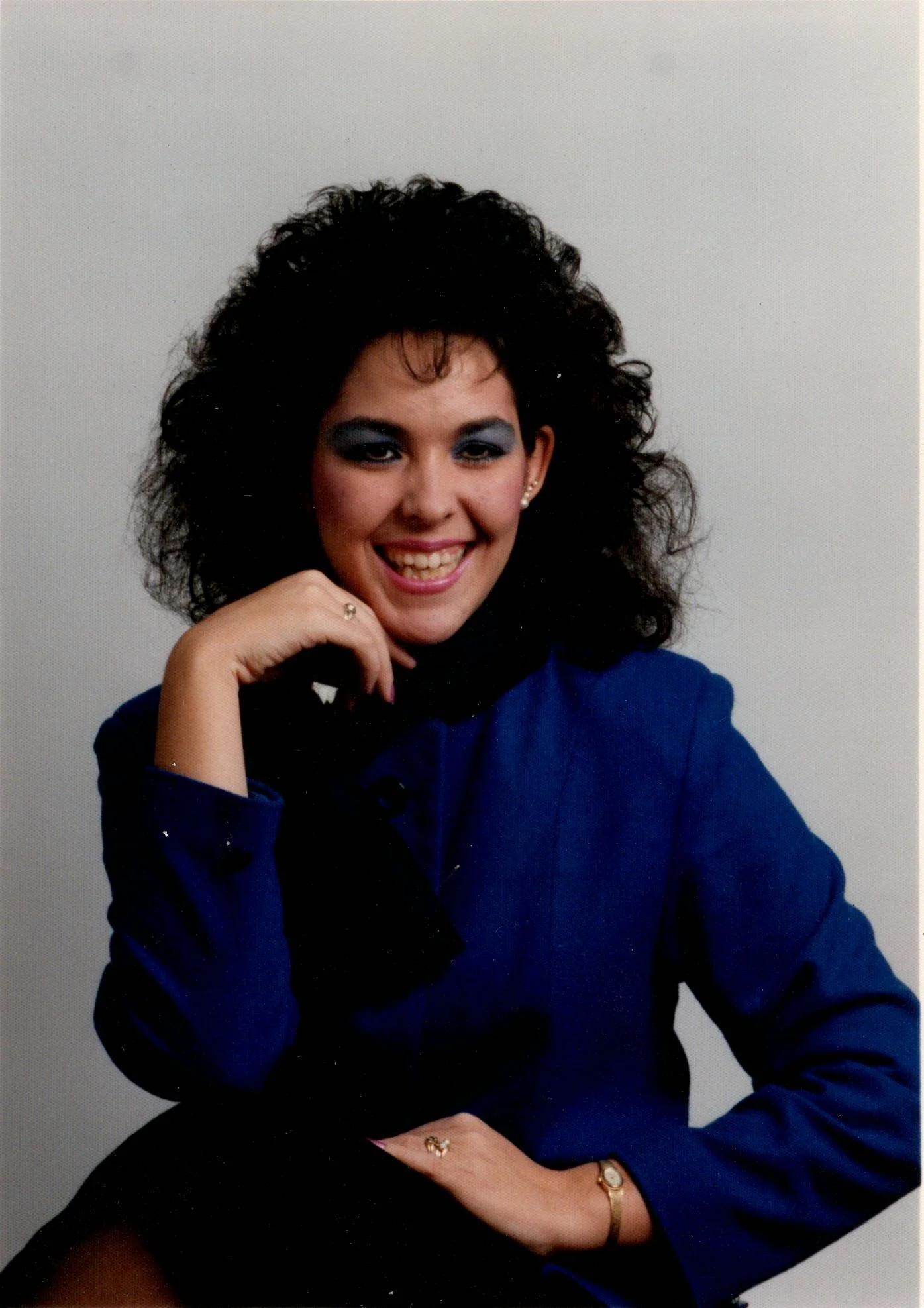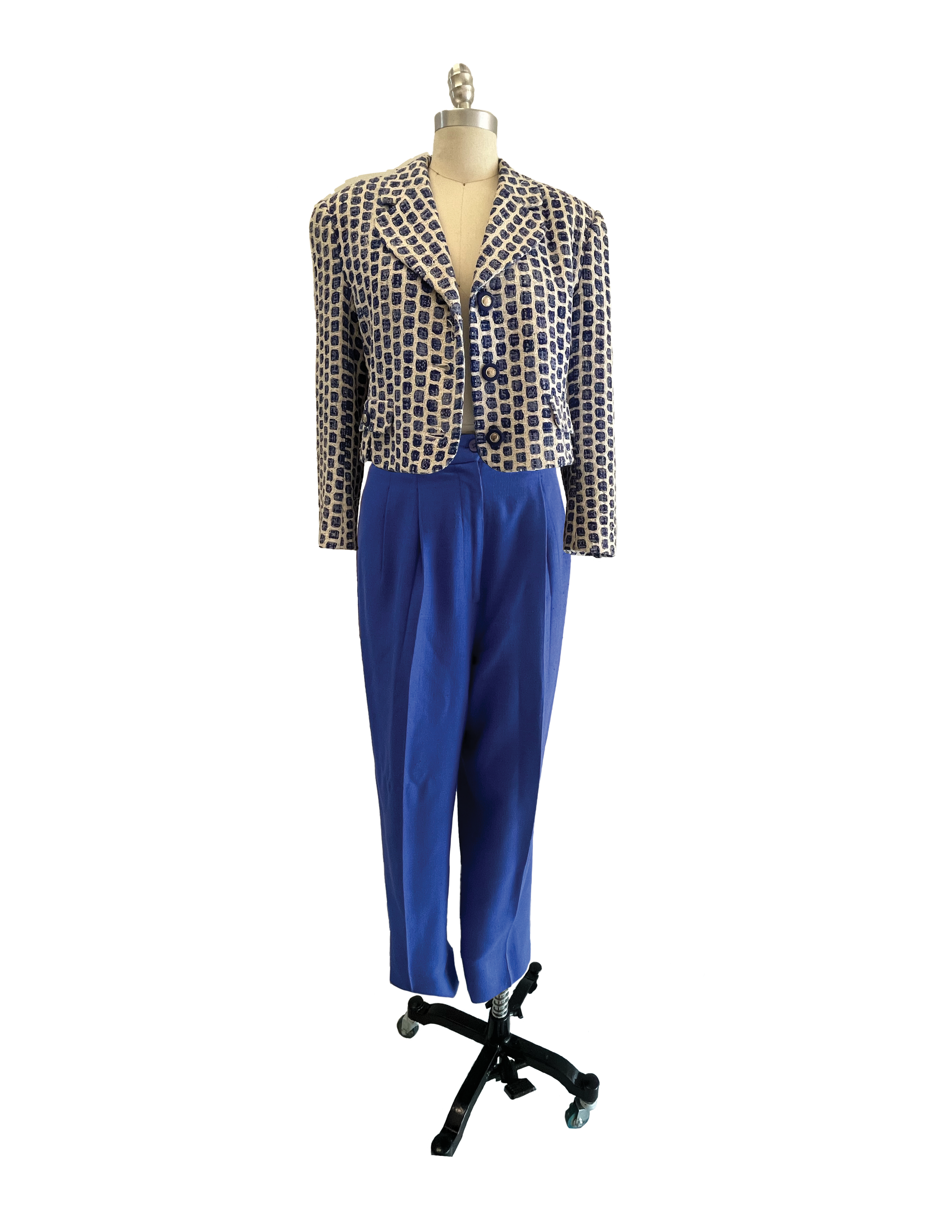In 1995, my mom bought a jacket, pants, and skirt to wear to work. On the day of an important meeting with the Science Museum of Virginia, which resulted in her selling a large energy contract and becoming the top-selling associate at Dominion Energy. She had recently moved from Ohio and was one of the newest associates, so being the top-selling associate was a big deal and memorable achievement. My mom set aside her successful career when she had me. She dedicated herself to being a mom, and the suit was hung away in her closet. It moved twice with her, once when she married my dad and another when we moved into the house we live in now. These garments hold personal value, they represent a season of my mom’s life, and every time she wore one of the pieces or passed them in her closet she was reminded of what the garments symbolized.
The 100% silk suit was made by Doncaster. Doncaster was a company that made suit to costumers' custom measurements and sold them via trunk shows. My mom knew a lady who hosted trunk shows for Doncaster and was asked to be a model for her. The models would stand on the grand staircase as guests arrived, and then would mingle with the guests so people could get an up close look at the garments. My mom was one of these models, which earned her a discount. She chose the fabrics and ordered this suit at one of these trunk shows.
Each conversation looks different, but they typically include two or more parties, the exchange of information, asking questions, and listening. Conversations are one of the main ways humans connect in a meanigful way. However, in a culture where almost all information is handed to us in a convenient and obvious way, and we do not have to think super hard, chew on the information, or ask questions to gain understanding. I have noticed that most conversations I am apart of information is stated, and not many questions are asked. Being asked a question is a rare, but special, and often a moment where connection is made deeper and stronger.
In mom’s story, I think about how the lack of questions affected my mom’s ability to tell her story. How many people asked my mom about her jacket when she wore it? How many people commented something more than “that’s so cute”? How many people knew how special those garments were to her? How long would the story of the garments go unshared if I never started this project? The history and value are there, but if it is never shared, re-told, or communicated it might have been lost forever.
What does it look like to start asking questions of our clothing in order to find or re-discover the value of fashion? What does it look like to have a conversation with our clothing? What would it look like for the meaning and value of clothing to be a normal topic of conversation?
As I seam ripped apart each section of the suit. I discovered new information about the garments that I did not know before. It was like having a converstion with the garments. All but the sleeves of the jacket were interfaced, the side of the jacket textile concealed by the lining had a different woven pattern. There were small marks and sweat stains which told the story of everyday life. The crotch of the pant lining had a tear in it which told the story of frequent movement. The textile--its design, its capabilities, its amount--told me what was possible to create. It was a point in the conversation when the garments made a definitive statement.
There are two pocket flaps on the front of the jacket, but there are no pockets; the flaps are for aesthetic purposes only. There are buttons sewn onto the flaps, however as I was taking the jacket a part I noticed that one side was missing the button. I asked my mom about when the button fell off, hoping for a great story to incorporate into the design, but she was surprised to hear that a button had fallen off. She had no idea that a front and center element of her frequently worn suit was gone. It makes me think about what else has gone missing without anyone noticing.
During the research for this project I realized that I was oblivious to the origins of the materials that I had been using. It had not even crossed my mind to look into where the fabric was made, who made the fabric, where the fiber was sourced from, who created the fiber, how the fiber was dyed, and why is was created in the first place. There were elements of design that I had not engaged in a conversation with, I had not asked questions. I do not think this applies to just me. I think people, including designers, are oblivious to the origins of materials. The work, knowledge, origins, and history of material have fallen off the blueprint of design. We have lost this aspect of design without even realizing it, and we need to find it again.
One of the traits my mom and I share is saving things that could be used in the future, but we have no specifics on what it might be used for. If it has the potential to be used, we keep it. I promise we are not hoarders, we purge every winter break but we just do not like throwing things away that could still have a purpose. This trait extended into me keeping muslin scraps from projects. Some are very odded shaped, and would conventionally not be used and thrown away. As part of this project was an exploration of having a conversation with our clothing, using the scraps was an oppurtunity to have a conversation with the muslin. I found myself asking, "What pattern piece do you want to have?" as if the fabric would answer back with their preferred piece. No verbal response, but the muslin scraps did dictate what piece(s) it could contain. This process took much longer than just using yardage. It was not convenient, the answers were not obvious, but it led me to restoring value to fabric I once called scraps.
As I continued to have conversations with my mom about her early years in Richmond and this suit, she mentioned that this suit was worn frequently. She had only bought it 6 months prior to selling the energy contract to the Science Museum of Virginia, so that is why she originally just told me it was a suit she wore to a meeting with the Science Museum. She said the suit was her go to "impression" suit because it had some pizzaz, was fresh, and was not stuffy like the typical black and navy suit. My main goal was to preserve the story of woman in the corporate workforce who wanted to be succesful, professional, and make a memorable impression, while wearing something she enjoyed. Preserve the story that I had many conversations with my mom about. Since the original suit was made to my mom's measurements, I wanted to make this new work outfit to my measurements to preserve yet another aspect of the original story. I also wanted the textile to determine posibilities for design, which required asking the textile questions and waiting for a response--I had to have a conversation with the fabric.
I hope you can have a conversation with these pieces. I hope you want to come closer, are enticed to ask questions, and to discover something new. My hope is that through giving you details to explore and garments with a specific history, you will begin to have a conversation with your clothing. Ask your garments: where did you come from? What are you made of? Why were you created? What is the significance of me wearing you? I hope you begin to ask the people around you about their clothing. Ask them: Why do you have this item? What makes this item special? Where did it originate from? What do you hope the future of this garment is? Use clothing to create and further you connection with people through conversation.
With hope for a future where our clothing is a source of conversation and connection,
Peyton








